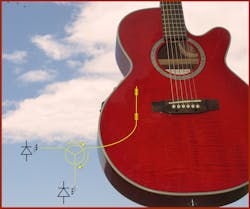FIBER BRAGG GRATINGS: Photonic guitar pickup has fiber Fabry-Perot cavity
Hans-Peter Loock and his colleagues at Queen's University (Kingston, ON, Canada) were experimenting with the use of fiber Bragg gratings (FBGs) as acoustic sensors for laser-induced photoacoustic spectroscopy of solid samples, and ended up taking a detour into the realm of music. To characterize the signal-to-noise ratio of their FBG sensor setups, they came to the realization that, as a tough acoustic test, there are few applications less tolerant of noise than high-fidelity audio recordings. As a result, they developed a FBG-based guitar pickup using a single strain-sensing FBG interrogated by a tunable laser diode.1
Now, the group, along with QPS Photronics (Montreal, QC, Canada), has created an improved version of the pickup that uses two FBGs in the same fiber to create a Fabry-Perot (F-P) cavity.2 One advantage of the two-FBG design over the previous single-FBG design is that the setup now offers independent adjustment of the acoustic sensitivity and the dynamic range, because now there are two physical parameters that can be tweaked: the cavity length (which determines the free spectral range) and the FBG reflectivity (which sets the cavity's finesse). There's a second advantage: If an acoustic frequency on the guitar's soundboard has a node (a point with zero amplitude) by the F-P cavity, the cavity is long enough to reach beyond the node to pick up vibrations where the amplitude is non-zero.
The photonic guitar pickup consists of a narrow-linewidth diode laser, the F-P cavity, an optical circulator, and a photodetector (see figure). The circulator diverts light from the cavity to the photodetector. The two FBGs that define the F-P cavity are chosen for low reflectivity to keep the cavity's finesse low; the cavity itself, connected to the rest of the components with a fiber-optic cable, is mounted to an acoustic guitar with adhesive tape.
High-quality audio
The researchers experimented with F-P cavities of 5, 10, and 25 mm lengths, all bounded by FBGs with reflectivities of 5–10%. The laser, with a center wavelength of 1542.14 nm and a linewidth of 200 MHz, was tuned to the midreflection point of an F-P cavity fringe; the laser driver periodically (a few times a minute) reset the laser's wavelength to the midpoint, compensating for long-term drift. Experimenting with placement of the pickup led to its optimum position halfway between the guitar's rim and its bridge. The researchers also tried the pickup on other musical instruments, including a solid-body bass guitar, a clarinet, a violin, and a harmonica.
Audio recordings of the acoustic guitar, as well as of some of the other instruments, showed that the photonic pickup's output approached the quality of a conventional high-quality pickup. One source of noise came from the fiber-optic cable's high sensitivity to movement; another came from the periodic resetting of the laser's wavelength, which produced an audible click.
Because the researchers wanted to have more control over the laser wavelength, they took a turnkey system by QPS and modified it. "Because the QPS system has not been designed for compactness, we had to keep it external to the guitar," says Loock. "Future versions will be built in-house and with size and cost in mind." A smaller size will allow the entire system to be placed on the guitar, eliminating the long fiber-optic cable—and its noise.
"Surprisingly, we haven't found any damping of high frequencies when using adhesive tape [as a mount], at least not when compared to conventional piezoelectric-transducer (PZT) pickups," says Loock. "This may be due to the FBG cavity working very well, or due to the fact that the PZT pickup also damps high frequencies. The second case is more likely, given the higher mass of a PZT pickup. In any case, we have commissioned a guitar from Dagmar Guitars (Niagara-on-the-Lake, ON, Canada) which will have the FBG sensors (5 to 10 of them) embedded in the wood and in different locations in the body. The FBG cavities will be mounted into a small groove in the wood and then covered with varnish, as is the rest of the guitar body."
Version for solid-body guitars
If a longer F-P cavity (or a cavity with higher finesse) were used, the linear range for the amplitude measurements would be smaller, but the sensitivity would increase, notes Loock—an advantage for certain musical instruments. "For example, solid-body guitars experience vibrations with much lower amplitudes and we can then simply use a longer cavity or a cavity with higher finesse," he says.
As for the cost of the photonic pickup system, Loock estimates it at more than $10,000, although he believes the cost could be dropped to less than $1000 with a moderately large manufacturing run of, say, a few hundred units. "I would guess that it can be lowered even more, should the technology catch on and move from recording studios into the hands of dedicated amateur musicians," he adds, noting that his students working on the project with him pointed out that electric guitars are "so twentieth century."
REFERENCES
- H.-P. Loock et al., Appl. Opt., Vol. 48, No. 14, May 10, 2009.
- N. Ballard et al., Appl. Opt., Vol. 49, No. 11, April 10, 2010.
About the Author
John Wallace
Senior Technical Editor (1998-2022)
John Wallace was with Laser Focus World for nearly 25 years, retiring in late June 2022. He obtained a bachelor's degree in mechanical engineering and physics at Rutgers University and a master's in optical engineering at the University of Rochester. Before becoming an editor, John worked as an engineer at RCA, Exxon, Eastman Kodak, and GCA Corporation.

